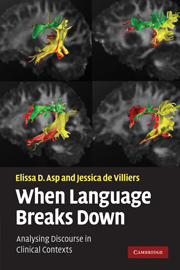Book contents
- Frontmatter
- Contents
- List of figures
- List of tables
- Acknowledgements
- Transcription conventions
- Introduction
- 1 Introduction to clinical discourse analysis
- 2 Theoretical and clinical contexts
- 3 Talk and speech – conversation analysis and intonation in English
- 4 Grammar
- 5 Phase and contexts of culture and situation
- 6 Study design
- 7 Differential diagnosis and monitoring
- 8 Cognitive models, inferencing and affect
- 9 Modelling information across domains
- Closing remarks
- Notes
- Appendix A Some basic grammatical terminology and relations
- Appendix B Inventory of codes
- References
- Author index
- Subject index
2 - Theoretical and clinical contexts
Published online by Cambridge University Press: 05 June 2012
- Frontmatter
- Contents
- List of figures
- List of tables
- Acknowledgements
- Transcription conventions
- Introduction
- 1 Introduction to clinical discourse analysis
- 2 Theoretical and clinical contexts
- 3 Talk and speech – conversation analysis and intonation in English
- 4 Grammar
- 5 Phase and contexts of culture and situation
- 6 Study design
- 7 Differential diagnosis and monitoring
- 8 Cognitive models, inferencing and affect
- 9 Modelling information across domains
- Closing remarks
- Notes
- Appendix A Some basic grammatical terminology and relations
- Appendix B Inventory of codes
- References
- Author index
- Subject index
Summary
Introduction
This chapter is intended to situate clinical discourse analysis in terms of relevant linguistic and non-linguistic fields and to orient readers to the developmental and degenerative disorders discussed. Sections 2.2 and 2.3 briefly sketch diagnostic criteria, epidemiological information, current treatment options and potential associations with neurophysiology in each area. Section 2.4 focuses on the theoretical background and sources for clinical discourse analysis. These include conversation analysis, ethnographic and interactional sociolinguistics, functional linguistic discourse analysis, cognitive and philosophical pragmatics, and formal (generative) linguistic models. Section 2.5 addresses the roles of neurology, neuropsychology, psychiatry and neuroimaging as essential in developing understanding of relationships between discourse behaviours and neurological disorders. Finally, section 2.6 addresses the role of normative discourse patterns in evaluating descriptions of the discourse of clinical groups.
Autism spectrum disorders
Autism spectrum disorder (ASD) is an umbrella term for a continuum of neurodevelopmental disorders, the causes of which are unknown. ASD manifests during infancy and is estimated to affect one in every 165 children (Fombonne et al. 2006). The first account of autism was published by Leo Kanner (1943). Since that time, an expansion in diagnostic criteria has led to the inclusion of more diagnostic categories in the autism spectrum. ASD now includes autism, Asperger syndrome and pervasive developmental disorders not otherwise specified.
ASDs affect more than one domain of functioning and are generally characterized by three core deficits:
1) impairments in socialization and interaction (e.g. lack of shared attention, lack of peer relationships).
2) impaired language and communication (delay or lack of functional speech, difficulties with conversation and pragmatics),
[…]
- Type
- Chapter
- Information
- When Language Breaks DownAnalysing Discourse in Clinical Contexts, pp. 10 - 28Publisher: Cambridge University PressPrint publication year: 2010



